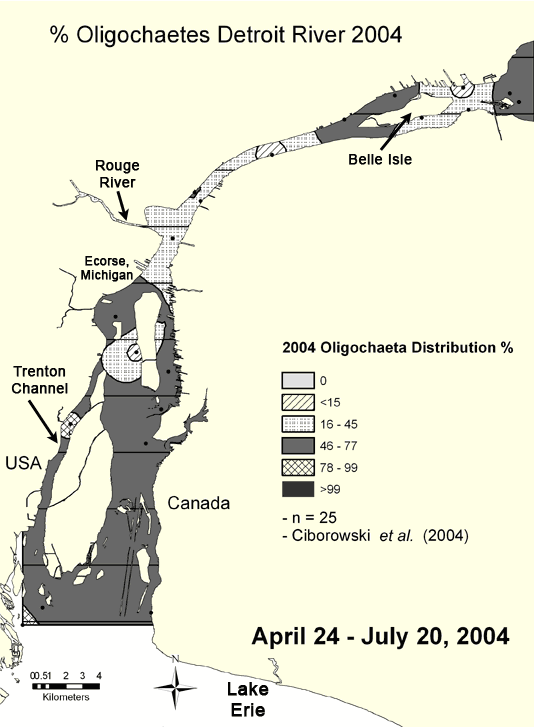Oligochaete Densities and Distribution - 2004
Estimates of oligochaete abundance are available from five Detroit River surveys conducted between 1968 and 2004 (Figure 2). Because the data were collected and compiled from various sources* there is variation in the number and location of sites sampled, and the times of year during which they were sampled. Riverwide estimates of average densities have ranged from about 1,200 worms per square meter (in 1999) to almost 7,000 per square meter (in 1991). Densities in 2004 were substantially higher than they were in 1999, suggesting that water quality was poorer in 2004. However, surveys have been conducted too irregularly to indicate whether the differences seen among years represent progressive changes in the river's condition or merely year-to-year variation. *[Data compiled from Thornley and Hamdy (1984), Farara and Burt (1993), Wood (2004), and Ciborowski et al. (2006)].

Figure 4. Percentage of Oligochaetes in the Detroit River in 2004 interpolated from data compiled from Ciborowski et al. (2006). Map by Anita Kirkpatrick.
Oligochaete abundances are especially useful at showing the location of point source pollution "hot spots" (This figure and figure 3, oligochaete density in 1999). Sites located along the Trenton Channel and one site (Ecorse site) located just downstream of Ecorse, Michigan (where U. S. Steel is located) have historically been recognized as among the most polluted areas of the Detroit River due to urban and industrial development along the shorelines. Mean oligochaete densities at these sites greatly exceeded the designated heavy pollution value of 5,000 per square meter in all years except 1999. Prior to 1980, these locations had between 100,000 and 1 million worms per square meter (Figure 5). Although conditions have dramatically improved and worm densities have been reduced by 80-90% since 1980, the numbers present suggest that these locations still fall in the "heavily polluted" category.
Go to full text of Oligochaete Densities and Distribution